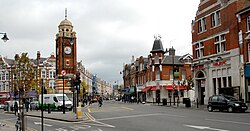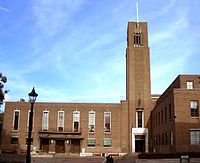Crouch End
| Crouch End | |
| Middlesex | |
|---|---|
 Crouch End Broadway | |
| Location | |
| Grid reference: | TQ295885 |
| Location: | 51°34’47"N, 0°7’25"W |
| Data | |
| Population: | 12,395 (2011) |
| Post town: | London |
| Postcode: | N8 |
| Dialling code: | 020 |
| Local Government | |
| Council: | Haringey |
| Parliamentary constituency: |
Hornsey & Wood Green |
Crouch End is an cvillage of northern Middlesex, approximately five miles from the City of London. It sits between Harringay to the east; Hornsey, Muswell Hill and Wood Green to the north; Stroud Green to the south; and Highgate to the west.
Name
The name Crouch End is derived from Middle English. A "crouch" meant cross while an "end" referred to an outlying area.[1][2] Some think that this refers to the borders of the parish, in other words, the area where the influence of the parish ends.
Its name has been recorded as Crouchend (1465), Crowchende (1480), the Crouche Ende (1482), and Crutche Ende (1553).[3] In 1593, it was recorded as "Cruch End".[4]
History
Crouch End was the junction of four locally important roads. A wooden cross was erected at the junction of these roads, roughly where the Clock Tower now stands, and a small settlement developed around it. Crouch End developed as an early centre of cultivation for Hornsey, and was where the farmsteads seem to have been grouped.[5]
From the later part of the eighteenth century, Crouch End, along with most of Hornsey, became home to wealthy London merchants seeking a refuge from the City. However, the area remained rural in character until around 1880.[6] The development of the railway changed the area significantly. By 1887 there were seven railway stations in the area. By the end of the 19th century, Crouch End had become a prosperous middle-class suburb due to an influx of mainly clerical workers who could easily commute to the city. The large old houses were replaced by comfortable middle-class housing, public parks were created, and a number of new roads and avenues, such as Elder Avenue and Weston Park, were laid out.
It expanded greatly in the late Victorian period and most of its present-day streets were built up in the late 19th century. By the mid-1930s Crouch End had a popular shopping centre that included a music hall in the middle of Topsfield Parade.

In the post-war years, the London-wide provision of social housing led to the building of council homes in and around Crouch End, Hornsey Vale and Hornsey itself. Many of the older houses in the area lay empty post-war and many were bought cheaply by speculative landlords who then let them out to the growing student populations of the Mountview and Hornsey Art College as well as to artists and musicians, who flocked to the area because of cheap rents.
The area became known as student bedsit land for several decades into the early 1980s until rising house prices changed the social profile of the area and progressively wealthier residents moved in. These social changes were accompanied by changes in the shop types over the period; the change brought a large number of estate agents, hairdressers, restaurants and cafes. However, Crouch End retains a selection of traditional high street shops including two butchers, a fishmonger, two grocers, three bakers, two bookshops, four children's shops, over 30 places to buy a cup of coffee, eight pubs and two cinemas.
About the village

- Hornsey Town Hall, built by the Municipal Borough of Hornsey as their seat of government in 1933-35.[7] It is now a Grade ll * listed building. The interior and exterior have been used several times as a location by the BBC series The Hour and other television programmes and films.
- Clocktower: a red-brick clock tower; a much-loved icon of Crouch End. It was designed by the architect Frederick Knight originally as a memorial to Henry Reader Williams, a local wine merchant and councillor
- Crouch End Hippodrome: originally opened on Tottenham Lane in July 1897 as the Queen's Opera House with a production of The Geisha. It is now a gym.
- Hornsey College of Art: established in 1880 by Charles Swinstead, it became "an iconic British art institution, renowned for its experimental and progressive approach to art and design education". In the 1970s the college was merged with Middlesex Polytechnic, which was later was relocated to a campus at Alexandra Palace. In 2005 the local council took it over to extending a primary school.
Society
- The Crouch End Neighbourhood Forum, set up in response to the "localism" initiative.
- Hornsey Historical Society, founded in 1971[8]
- The Kings Head, a comedy venue.
- Crouch End Festival Chorus
- Crouch End Festival
Cycling and Walking

The Parkland Walk runs along the southern rim of Crouch End. The Parkland Walk is a shared use path for both pedestrians and cyclists. Westbound, the path links the area to Highgate, whilst in the east, the route ends in Finsbury Park. The path runs predominantly in a cutting through Crouch End.[9] The Parkland Walk is part of the Capital Ring route, which is signposted.
Outside links
- Crouch End Festival
- Crouch End Community
- Crouch End Neighbourhood Forum
- History of Crouch End: Hornsey Historical Society]
References
- ↑ "How London's Hills Got Their Names". Londonist. https://londonist.com/2016/04/how-london-s-hills-got-their-names.
- ↑ "Crouch End, Haringey". http://hidden-london.com/gazetteer/crouch-end/. Retrieved 23 January 2018.
- ↑ Mills, A. D. (2010). A Dictionary of London Place-Names. Oxford. pp. 69-69. ISBN 9780199566785.
- ↑ "John Norden's map of Middlesex". Jonathan Potter Ltd.. http://www.jpmaps.co.uk/map/id.33043. Retrieved 16 December 2017.
- ↑ A History of the County of Middlesex - Volume 6 pp 107-111: Friern Barnet, Finchley, Hornsey With Highgate (Victoria County History)
- ↑ The transcribed 1829–1848 diaries of William Copeland Astbury describe in great detail London life of the period, including walks to Crouch End.
- ↑ Civic Pride in Hornsey (Hornsey Historical Society, 2006)
- ↑ Hornsey Historical Society
- ↑ "Home - The Friends of the Parkland Walk". https://www.parkland-walk.org.uk/.